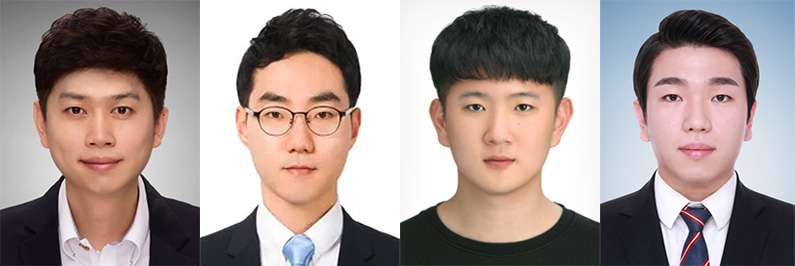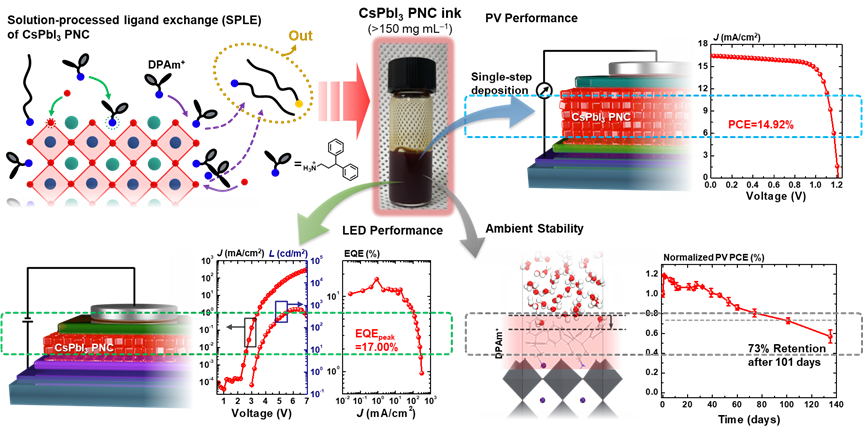커뮤니티
부경투데이
- 국립 부경대학교의 다양한 모습과 소식을 접하시면 부경대학교가 한번 더 가까워집니다.
| 부경대·한양대 공동연구 '주목'(PKNU and Hanyang university's joint research drew attention from the academia) | |||
| 작성자 | 대외협력과 | 작성일 | 2023-01-06 |
| 조회수 | 823 | ||
| 부경대·한양대 공동연구 '주목'(PKNU and Hanyang university's joint research drew attention from the academia) | |||||
 |
대외협력과 |  |
2023-01-06 |  |
823 |
부경대·한양대 공동연구팀, 태양전지·LED 동시 구현 첨단소재 개발
- 재료과학 세계 권위 학술지 <Advanced Materials>에 발표

△ 공동연구팀 사진(왼쪽부터 이보람, 최효성, 송호찬, 정우현).
국립부경대학교와 한양대학교 공동연구팀이 차세대 태양전지와 발광다이오드(LED)를 동시에 구현할 수 있는 첨단 단일 소재를 개발했다.
부경대 물리학과 이보람 교수와 한양대 화학과 최효성 교수, 송호찬·정우현 박사과정생 등 연구팀은 ‘페로브스카이트 나노결정 기반 잉크’를 개발하고, 연구성과를 재료과학 분야 세계적 권위 학술지인 <Advanced Materials>(IF=32.086)에 최근 발표했다.
이 연구성과를 담은 논문은 ‘A Universal Perovskite Nanocrystal Ink for High-Performance Optoelectronic Devices’이다.
연구팀이 개발한 첨단소재는 광활성 반도체 소재인 페로브스카이트 나노결정(PNC)을 이용해 높은 광발광효율과 안정성을 구현한 SPLE-PNC 잉크다.
차세대 태양전지, LED, 광검출기 등에 사용되는 광전자소자를 제작하기 위해서는 PNC 잉크를 한 층씩 여러 번 코팅하는 방식을 이용한다. PNC 잉크는 빛 흡수 능력이 뛰어나고 광발광효율과 색순도가 높지만, 여러 층을 코팅하는 공정을 거치면 표면결함이 발생해 광전자소자의 성능이 저하되는 한계가 있었다.
연구팀은 ‘다이페닐프로필암모늄 아이오다이드(DPAI)’라는 화합물을 사용하는 방식으로 표면결함을 억제하는 데 성공했다. 그 결과 SPLE-PNC 잉크는 박막 광발광효율이 기존 대비 37%나 높아졌다.
특히 구동방식이 반대여서 다른 잉크를 적용해야 하는 태양전지와 LED에 이 잉크를 각각 적용한 결과 태양전지의 광변환효율과 LED의 발광효율을 모두 크게 높이는 것으로 나타났다.
또 이 잉크는 한 번의 코팅만으로 필요한 두께의 박막을 형성할 수 있어 광전자소자 공정을 대폭 간소화시켰다. 이 잉크를 적용한 태양전지는 지금까지 보고된 PNC 태양전지 중 안정성도 가장 높았다.
연구팀은 이번 첨단소재 개발 기술이 차세대 태양전지, LED, 광검출기 등의 PNC 광전자소자 상용화를 앞당길 수 있을 것으로 내다봤다.
한편 이번 연구는 과학기술정보통신부와 한국연구재단의 기초연구사업(BrainLink/나노 및 소재기술개발/중견연구/기초연구실) 등의 지원으로 수행됐다. <부경투데이>

△ 연구관련 이미지. (위 왼쪽)DPAI를 이용한 용액상 리간드 교환 모식도 (위 오른쪽)태양전지 소자 구조 및 효율 그래프 (아래 왼쪽)발광다이오드 소자 구조 및 효율 그래프 (아래 오른쪽)수분 침투 시뮬레이션 및 태양전지 소자 안정성 그래프
PKNU and Hanyang university joint research team developed advanced materials that can implement solar cells and LED simultaneously
- published in <Advanced materials>, a world-renowned academic journal in the field of materials science
A joint research team from Pukyong National University and Hanyang university has developed a high-tech single material that can realize next-generation solar cells and light emitting diodes (LED) at the same time.
A research team led by professor Lee Bo-Ram from the department of physics at Pukyong National University and professor Choi Hyo-Seong and phd candidates Song Ho-Chan and Jeong Woo-Hyeon from the department of chemistry at Hanyang university developed ‘Perovskite nanocrystals-based ink' and published the research results in <Advanced materials> (IF=32.086), a world-renowned academic journal in the field of materials science.
The thesis containing their research result is ‘A universal Perovskite nanocrystal ink for high-performance optoelectronic devices’.
The advanced material developed by the research team is SPLE-PNC ink, which uses perovskite nanocrystal (PNC), a photoactive semiconductor material, to materialize high light luminous efficiency and stability.
To manufacture optoelectronic devices used in next-generation solar cells, LEDs, and photodetectors, a method of coating multiple layers of PNC ink layer by layer is used. PNC ink has excellent light absorbing ability and high light emitting efficiency and color purity, but it has limitations in that the performance of optoelectronic devices deteriorates due to the occurrence of surface defects through the process of coating several layers.
The research team succeeded in suppressing surface defects by using a compound called 'diphenylpropylammonium (DPAI)’. As a result, SPLE-PNC ink has a 37% higher light luminous efficiency compared to the existing thin film.
As a result of applying this ink to a solar cell and an LED, which require different inks due to the opposite driving method, both the light conversion efficiency of the solar cell and the luminous efficiency of the LED were greatly improved.
In addition, this ink greatly simplifies the process of optoelectronic devices because it can form a thin film of the required thickness with just one coating. Solar cells using this ink have the highest stability among PNC solar cells reported so far.
The research team predicted that the development technology of this advanced material could accelerate the commercialization of PNC optoelectronic devices such as next-generation solar cells, LEDs, and photodetectors.
This research was carried out with support from the Ministry of science and ICT and the National research foundation of Korea's basic research in science & engineering (brainlink, nano and material technology development, mid-career researcher program and basic research laboratory). <Pukyong Today>